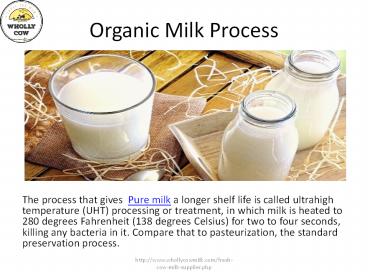Organic Milk Process - PowerPoint PPT Presentation
Title:
Organic Milk Process
Description:
The process that gives Pure milk a longer shelf life is called ultrahigh temperature (UHT) processing or treatment, in which milk is heated to 280 degrees Fahrenheit (138 degrees Celsius) for two to four seconds, killing any bacteria in it. – PowerPoint PPT presentation
Number of Views:44
Title: Organic Milk Process
1
Organic Milk Process
- The process that gives Pure milk a longer shelf
life is called ultrahigh temperature
(UHT) processing or treatment, in which milk is
heated to 280 degrees Fahrenheit (138 degrees
Celsius) for two to four seconds, killing any
bacteria in it. Compare that to pasteurization,
the standard preservation process.
2
Pasteurization
- A raw milk must be pasteurized. This means it
goes through a controlled process of heating and
re-cooling to slow down the growth of bacteria
and keep it from spoiling too quickly.
3
Separation and Standardization
- Milk separation refers to the process of
separating some or all of the cream from the milk
to produce the different milk types we like to
drink. Standardization simply ensures the fat
content remains consistent over time, by ironing
out the variability of milk collected from the
farm.
4
Homogenization
- Homogenized involves passing it through a small
hole at very high pressure so the fat globules
break down and disperse. After homogenization,
the milk wont separate again, which means no
more scooping out the creamy layer at the top of
your full-fat bottle.
5
Chilling
- The milk is kept at a constant cool temperature
to keep bacteria levels low.
6
Bottling
- Under the bottling process each bottle is
granted its hard-earned organic label, to make
it easy for you to identify when you are
shopping. its not just the farm that must be
certified organic and go through an annual
inspection, but the milk tanker and the dairy
does too. This is to ensure that they have the
procedures in place to keep the transport and
bottling process completely separate from
non-organic milk.
7
(No Transcript)































